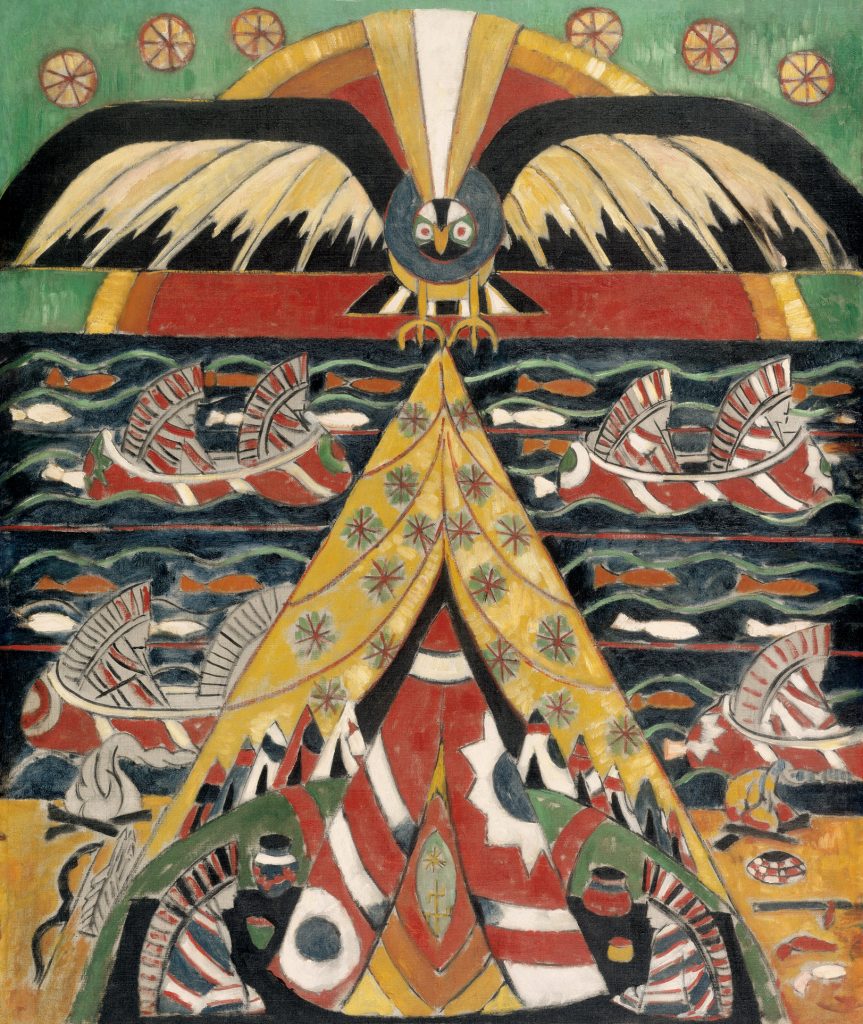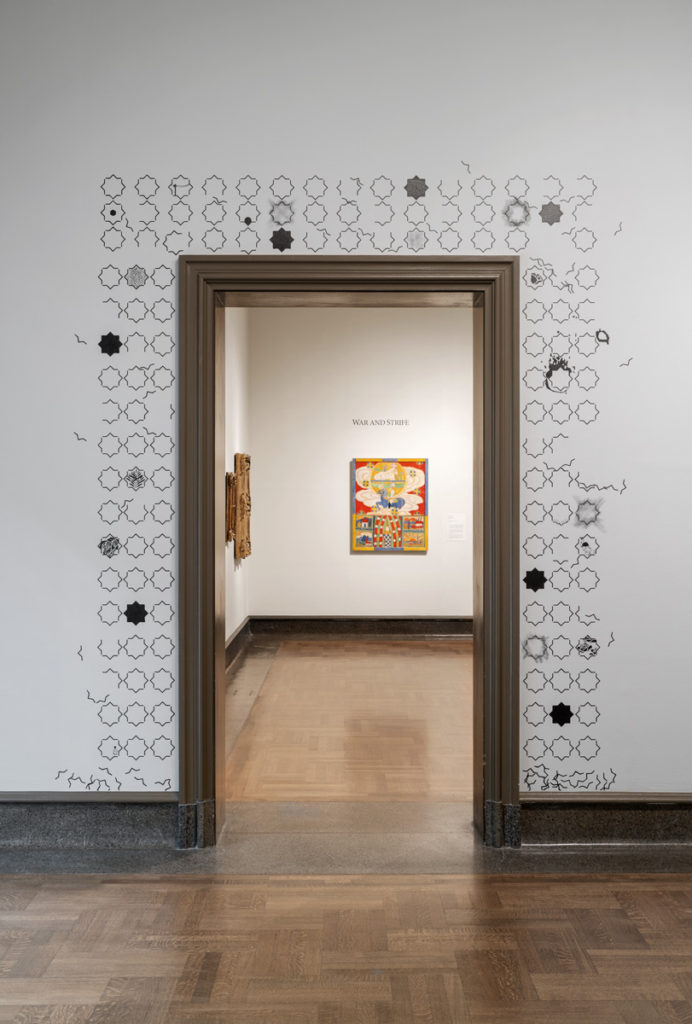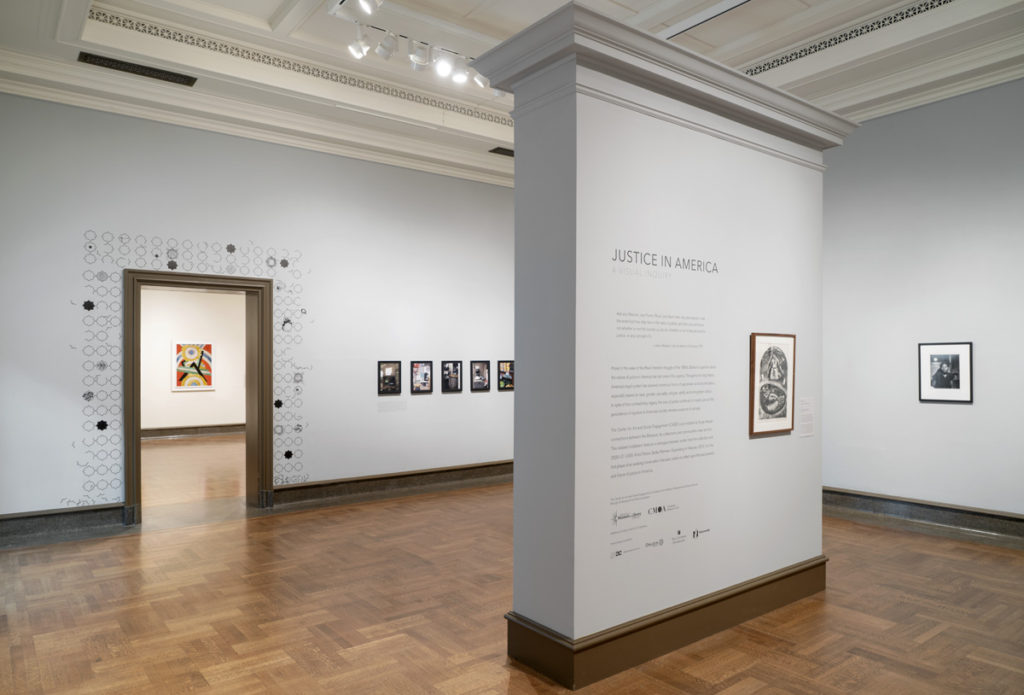I started typing out these thoughts as an Instagram post, only to stop myself, copy and paste them here, and continue to write them as a Minus Plato post instead. As I continue to post, repost, amplify and comment on Instagram, I too often forget that one reason I started this blog in the first place was a frustration with the relentlessness (and perverseness) of generating so much content (aka money) for a corporation. (It might help to know I have recently been reading the writings of Claire Fontaine on ‘Human Strike’). Anyway, here is what I wanted to write there, but which instead I am writing here.
I find myself thinking out loud about these two Marsden Hartley paintings as sightlines from Sa’dia Rehman’s stunning The Land of Promise exhibition at The Center for Art and Social Engagement (CASE) at the Columbus Museum of Art. While I have not yet experienced the work in person, thanks to these photographs of Luke Stettner on the CMA website, I am able to gain some access into the work that Rehman created for the gallery. In two of the photographs, we can see through into another gallery that appears to be focused on the theme ‘War and Strife’ and which includes two of the museum’s works by Marsden Hartley.
Hartley painted both works – Berlin Ante War and Pre-War Pageant – in 1914, the same year he also worked on his so-called “Amerika Series”. I learned from the book Marsden Hartley: The German Paintings 1913-1915, edited by Dieter Scholz (and which was a generous gift from my friend, curator and writer Bill Horrigan), that the German spelling ‘Amerika’ was possibly used by Hartley to attract the German modernist artists he wanted to associate with at the time,. Included in this series, we works such as American Indian Symbols and Indian Fantasy, with the latter title taking on a markedly problematic resonance when engaged alongside the following statement in a letter that Hartley wrote to photographer Alfred Stieglitz:
I find myself wanting to be an Indian – to paint my face with the symbols of that race I adore…to go to the West and face the sun forever – that would seem the true expression of human dignity.
While there is a substantial amount of scholarship written on Hartley and Native American culture and art (although I would be interested to know how much of this scholarship has been written by Indigenous art historians), I want to focus on these sightlines from Sa’dia Rehman’s The Land of Promise. A text on the museum website describes the work as follows:
In line with Rehman’s practice, the wall drawing engages the gallery architecture, and combines motifs from a range of sources. Decorative patterns, typical of art of the Islamic world, interweave with images of migration, incarceration, and protest. Visitors may recognize some of these motifs from works in CMA’s collection. Rehman describes The Land of Promise as a border. The term evokes the geography of migration and detention, but also traditions of decoration and adornment. Stenciled and hand-drawn onto the gallery walls, Rehman’s drawing will expand over the course of her yearlong fellowship and engage feedback from visitors. Rehman has designated each of the four walls with a specific theme: Horizon; Land; Future; and Afterlife. Ultimately, the drawing will run continuously around the room.
I was especially intrigued by the artist’s attention to and use of decorative features and the invitation to engage with the work in terms of motifs from works in the CMA collection, and specifically how they overlap. Are there decorative motifs that Rehman uses that echo similar motifs in the collection? Or are there only thematic resonances? Of course, without experiencing the work in person, I cannot answer this question. Yet, the sightlines to Hartley’s two paintings made me wonder if Rehman was in some way engaging, in a general way, with this artist’s attention to iconography and decorative motifs. Yet the ‘Amerika’ series and Hartley’s ‘white move to innocence’ in ‘playing Indian’ (see Eve Tuck and Wayne K. Yang’s essential essay ‘Decolonization is Not a Metaphor’) kept coming back to me within the framework of Rehman’s intervention in the museum space and collection. It was then that the words of the exhibition’s title – The Land of Promise – started to resemble the series of broken promises to Native American nations throughout this country’s history, most explicitly shown by the breaking of treaties (I remember seeing the sobering exhibition Nation to Nation: Treaties Between the United States and American Indian Nations at the National Museum of the American Indian). But then, it dawned on me that the sightlines from The Land of Promise to Marden Hartley’s two 1914 ‘German’ paintings were also temporal sightlines through the colonial history of the US, Germany and other European nations that only a collecting museum like the CMA can show. What happens when commissioned works like Rehman’s gives us the capacity to see through the institution of the museum as the too-often unspoken purveyor of a ‘white move to innocence’? Sure, we can critique Hartley for ‘playing Indian’ in his work, but what does it mean for us to register that there is a direct continuum – a sightline – between the Museum für Völkerkunde in Berlin where Hartley saw looted cultural and artistic works of the tribes of the Pacific Northwest that may have inspired the eagle in Indian Fantasy, and the Columbus Museum of Art, that still holds Inuit soap stone sculptures, Pueblo pottery, Navajo weaving and no doubt other Indigenous artworks and cultural objects in its collections? How did they get there? Who benefits from them being there today? And, perhaps most importantly, what promises are we continuing to break, not just here in Ohio, but across this land, by holding onto them?


